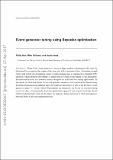| dc.contributor.author | Ilten, P. | |
| dc.contributor.author | Williams, M. | |
| dc.contributor.author | Yang, Y. | |
| dc.contributor.author | Ilten, Philip J | |
| dc.contributor.author | Williams, Michael | |
| dc.contributor.author | Yang, Yang | |
| dc.date.accessioned | 2019-03-01T16:40:11Z | |
| dc.date.available | 2019-03-01T16:40:11Z | |
| dc.date.issued | 2017-04 | |
| dc.date.submitted | 2016-11 | |
| dc.identifier.issn | 1748-0221 | |
| dc.identifier.uri | http://hdl.handle.net/1721.1/120587 | |
| dc.description.abstract | Monte Carlo event generators contain a large number of parameters that must be determined by comparing the output of the generator with experimental data. Generating enough events with a fixed set of parameter values to enable making such a comparison is extremely CPU intensive, which prohibits performing a simple brute-force grid-based tuning of the parameters. Bayesian optimization is a powerful method designed for such black-box tuning applications. In this article, we show that Monte Carlo event generator parameters can be accurately obtained using Bayesian optimization and minimal expert-level physics knowledge. A tune of the PYTHIA 8 event generator using e⁺e⁻ events, where 20 parameters are optimized, can be run on a modern laptop in just two days. Combining the Bayesian optimization approach with expert knowledge should enable producing better tunes in the future, by making it faster and easier to study discrepancies between Monte Carlo and experimental data. | en_US |
| dc.description.sponsorship | United States. Department of Energy (Grant DE-SC0010497) | en_US |
| dc.description.sponsorship | United States. Department of Energy (Grant DE-FG02-94ER40818) | en_US |
| dc.publisher | IOP Publishing | en_US |
| dc.relation.isversionof | http://dx.doi.org/10.1088/1748-0221/12/04/P04028 | en_US |
| dc.rights | Creative Commons Attribution-Noncommercial-Share Alike | en_US |
| dc.rights.uri | http://creativecommons.org/licenses/by-nc-sa/4.0/ | en_US |
| dc.source | arXiv | en_US |
| dc.title | Event generator tuning using Bayesian optimization | en_US |
| dc.type | Article | en_US |
| dc.identifier.citation | Ilten, P. et al. “Event Generator Tuning Using Bayesian Optimization.” Journal of Instrumentation 12, 4 (April 2017): P04028–P04028 © 2017 IOP Publishing Ltd | en_US |
| dc.contributor.department | Massachusetts Institute of Technology. Laboratory for Nuclear Science | en_US |
| dc.contributor.mitauthor | Ilten, Philip J | |
| dc.contributor.mitauthor | Williams, Michael | |
| dc.contributor.mitauthor | Yang, Yang | |
| dc.relation.journal | Journal of Instrumentation | en_US |
| dc.eprint.version | Author's final manuscript | en_US |
| dc.type.uri | http://purl.org/eprint/type/JournalArticle | en_US |
| eprint.status | http://purl.org/eprint/status/PeerReviewed | en_US |
| dc.date.updated | 2019-02-06T15:24:22Z | |
| dspace.orderedauthors | Ilten, P.; Williams, M.; Yang, Y. | en_US |
| dspace.embargo.terms | N | en_US |
| dc.identifier.orcid | https://orcid.org/0000-0001-5534-1732 | |
| dc.identifier.orcid | https://orcid.org/0000-0001-8285-3346 | |
| dc.identifier.orcid | https://orcid.org/0000-0002-0025-5914 | |
| mit.license | OPEN_ACCESS_POLICY | en_US |
